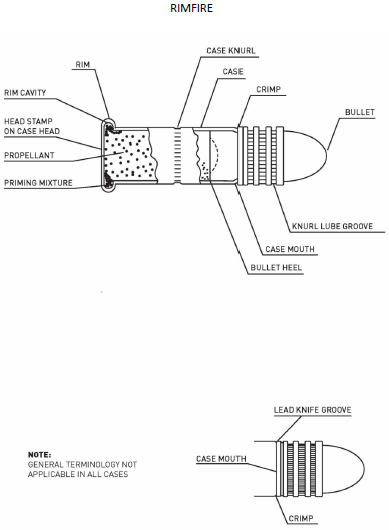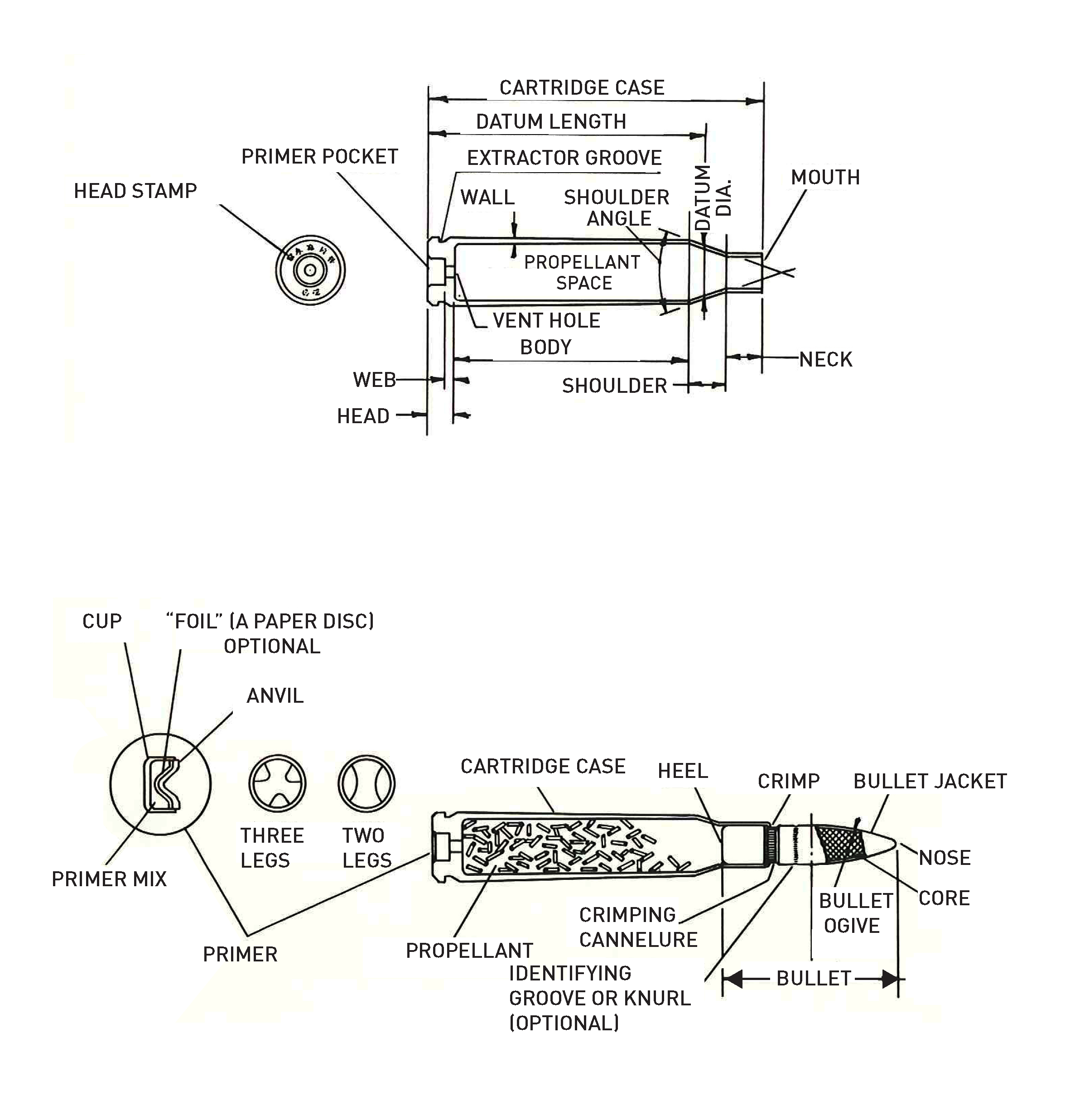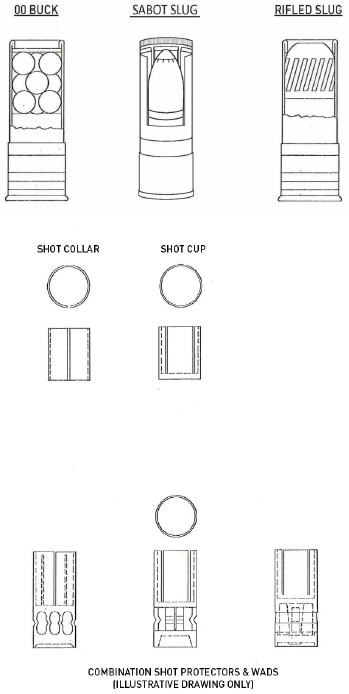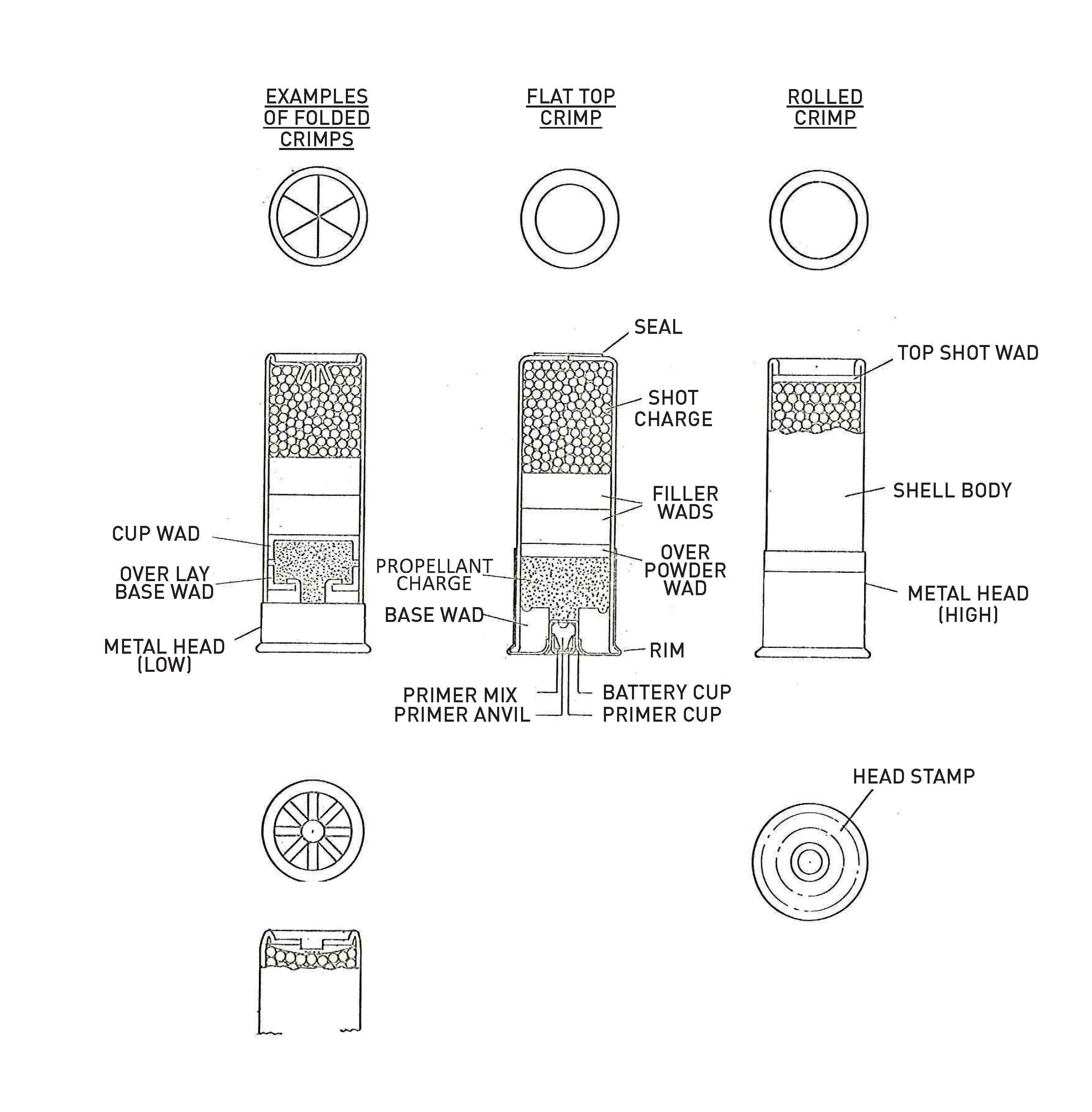It is safe to shoot 223 Remington ammunition in a 5.56 military specification chamber. The firearm manufacturer can verify whether the chamber in your firearm meets that definition.
However, due to the sizeable number of “wildcat” or non-military specification 5.56 chamber geometries in existence, SAAMI recommends that you consult the firearm owner’s manual or contact the firearm manufacturer for further guidance as to whether your firearm can safely shoot 223 Remington ammunition.
However, it is not safe to shoot “5.56,” “5.56 NATO,” or “5.56x45mm” ammunition in a barrel marked as being chambered in 223 Remington for a number of reasons. The main reason being that a barrel marked as chambered in 223 Remington will have a shorter throat into the rifling than a “5.56” barrel which may cause increased pressure if the “5.56” ammunition is fired in it. This can result in serious injury or death to the user and/or bystanders, as well as damage to the firearm.
For more information on interchangeability of cartridges and chambers for sporting cartridges, go here.
For information on equivalent/historical names of sporting cartridges, go here.
SAAMI defines a headspace gauge as “a device used in a firearm to determine the distance between the breech face and the chamber surface on which the cartridge seats.” Headspace gauges are fixed gauges and can only provide the user with knowledge of whether the distance between the breech face and the cartridge seating surface is shorter than the length of the gauge being used or greater than or equal to the length of the gauge being used.
Go Gauge – A “GO” gauge is made to a length the breech is expected to be able to close and is typically made to a length equal to or very slightly longer (.0001 to .0002” / 0.003 to 0.005 mm) than the minimum headspace length shown on the appropriate chamber drawing.
No-Go Gauge – In general gauging terms, a “NO-GO” gauge when used on the item being measured is expected, if within specifications, to not pass. For a headspace gauge, this means the breech should NOT close on a “NO-GO” gauge.
The actual length of a “NO-GO” headspace gauge will be the maximum allowable headspace length as shown on the appropriate chamber drawing OR SHORTER, depending on the application and manufacturer’s discretion. For example, the length of the “NO-GO” gauge used in final inspection prior to packaging a firearm is typically several thousandths of an inch less than the maximum allowable SAAMI headspace specification in order to ensure sufficient wear allowance exists for the expected useful life of a firearm when new.
Field Gauge – The “Field Gauge” was developed by the U.S. Military to determine if a firearm was still safe to operate in wartime battlefield conditions. SAAMI does not recognize the term “Field Gauge” and has no definition for the gauge.
As a final note, headspace gauges are subject to wear and may become damaged with use or accident. As such, they must routinely be checked for actual length (calibrated) to ensure they are within tolerances for their intended use.
SAAMI does not “approve” or “certify” firearms or ammunition products. SAAMI creates the voluntary standards for performance, dimensions, and other characteristics. In order to determine if a particular product was made in accordance with those voluntary standards, contact the manufacturer.
The standardization of a cartridge design, chamber design, and operating parameters promote safety, reliability, and interchangeability of firearms and ammunition. SAAMI standards become publicly available by way of the American National Standards Institute (ANSI) standards. The SAAMI/ANSI standards are created and maintained by SAAMI and are available on the SAAMI website.
A sponsoring company submits a complete submission package to the office of the SAAMI Director of Technical Affairs. Complete submission packages are scheduled for introduction at the next regularly scheduled SAAMI meeting (in either January or June). At the meeting, a complete package is submitted to the Joint Technical Committee (JTC). Members of the JTC have a period of time (typically 6 months) to review the submission package and request resolution to any safety, reliability and interchangeability issues identified during the review. Once all issues identified during the review are addressed the JTC votes on approving the new cartridge. If approved by the JTC the new cartridge is included in the JTC report to the SAAMI Board of Directors. If there are no objections at the Board level, the cartridge becomes a new SAAMI-accepted cartridge.
Only a Voting or Associate SAAMI member company is allowed to submit a cartridge and chamber design for consideration of acceptance to the SAAMI Technical Standards.
Any SAAMI Voting or Associate Member can sponsor the introduction of a new cartridge. Someone wishing to submit a cartridge who is neither a Voting nor Associate Member must partner with a SAAMI Associate or Voting Member, who can then sponsor the cartridge.
SAAMI membership is open only to corporate entities, not individuals. To qualify for membership, the company must be a domestic primary manufacturer, or designer of sporting firearms, ammunition, components, or propellant selling within the United States.
For more information, please see: Membership Requirements
SAAMI does not conduct independent product testing. There are several independent testing companies capable of testing product to the SAAMI standards, including:
– Q.C. Metallurgical, Inc.
– NTS Chesapeake
– Dayton T. Brown Inc.
Disclaimer: SAAMI makes no recommendation on any of these testing companies. You should conduct due diligence on any product testing firm to determine the company’s expertise to conduct any test you would ask them to conduct.
A “Wildcat Cartridge” is a cartridge for which the dimensions, performance and pressure levels standards have not been standardized by a recognized standards-setting organization such as SAAMI, the C.I.P., NATO or other governmental body.
The repeated re-chambering of a cartridge or shotshell in a firearm may cause physical damage to the case or hull, which could prevent the cartridge or shotshell from firing. It can also damage the primer pellet, resulting in a misfire. Repeated re-chambering of a cartridge can push the projectile deeper into the case and thereby reduce internal case volume and increase chamber pressure. Do not repeatedly re-chamber the same cartridge.
There are a number of pistol cartridges that fall into this category, and in accordance with the ANSI/SAAMI standard, Z299.2-2015, there are only two recognized names for each cartridge – a full and an abbreviated version. For these, the correct, recognized presentations are 25 Automatic (25 Auto), 32 Automatic (32 Auto), 380 Automatic (380 Auto), 38 Automatic (38 Auto), and 45 Automatic (45 Auto).
A decimal point is never included preceding the numerical caliber component of any cartridge name. That is, “308 Win” is correct, but “.308 Win” is not. Of course, decimals are included as needed in metric cartridge names such as the 6.8mm Remington SPC.
Reference ammunition assessments may be purchased from the SAAMI Technical Office.
Measuring firearm chamber pressure is a quality control procedure associated with the loading of ammunition. However, because chamber and barrel dimensions also affect pressure, a necessary part of the understanding of any recorded pressure level is knowing the precise method and with what equipment the results were obtained. SAAMI has taken great care in creating standards which define, in detail, the methods and equipment which it recommends in order to assure reproducible and meaningful results.
In spite of many years of research, no economical or simple substitute has yet been found for the complicated and expensive methods and equipment used by firearms and ammunition manufacturers for pressure determinations.
Published pressure data is only valid for measurements made using equipment as detailed in the American National Standards Published by SAAMI, when calibrated and operated in accordance with the procedures therein.
For many years gun chamber pressure units had been commonly referred to as “pounds per square inch”, which was not technically correct. The older method of pressure measurement involves a piston through the side of the chamber compressing a lead or copper cylinder in which the measurement of the degree of compression is indicative of the maximum relative pressure generated. With the advent of the electronic transducer, it became necessary to indicate by some means the method and equipment used to determine the pressure values given. This is important, since the pressure values determined by one method cannot be mathematically converted to values for another, despite claims to the contrary. Likewise, the limiting pressure values for the different systems are not interchangeable.
SAAMI created the designations of “Lead Units of Pressure” (abbreviated LUP) and “Copper Units of Pressure” (abbreviated CUP) to clearly indicate the system used in determining pressure results and/or limits. These designations apply only to values with the particular crushers, test gages and methods as outlined in SAAMI technical procedures. The terms LUP and CUP represented a change in name only. The pressure testing equipment, techniques and the numbers themselves are essentially the same as those associated with pressure units expressed as so many “pounds per square inch” prior to the advent of the piezoelectric transducer method. The term “psi” (pounds per square inch) is now reserved for electronic (piezoelectric) methods of measuring pressure, which is the predominant system in use today.
By convention, units of pressure are reduced by a factor of 100 when put in tabular form. For example, 100 LUP is actually 10,000 LUP. 480 CUP is actually 48,000 CUP and 220 psi is actually 22,000 psi.
There are two primary methods of measuring shotshell velocity, one using optical screens and the other using inductance coils.
The optical screens rely on the shadow created by the shot passing between a light source and a detector to generate the start and stop pulses needed to trigger a chronograph. Predominantly, the optical screens are used for measuring the velocity of non-lead slugs and some non-lead shot loads where the material will not be sensed by inductance coils.
The inductance sensor is composed of two coils of wire spaced three feet apart that are part of a tuned oscillator circuit. The inductance of the coils is changed as the shot charge passes through and the change in oscillator frequency is detected with a frequency modulation (“FM”) discriminator circuit that provides the output pulses used to trigger the chronograph.
The method preferred by the ammunition industry uses the inductance sensing technique that provides more uniform results due to the fact that the velocity is sensed at the trailing, and characteristically the most dense, portion of the shot string and not by stray or leading pellets which can trigger optical screens. When this happens, the elongation of the shot string can cause optical screens to trigger on different parts of the shot string, causing erroneous, high, velocity readings.
The gases generated by the burning of propellant in a firearm exert a force that not only pushes the bullet or shot charge forward out of the barrel, but also drives the firearm back against the shooter.
From a shooter’s perspective, there are two aspects to recoil. One, absolute recoil, the other “felt recoil”. Absolute recoil is described by invariable laws of physics while the “felt recoil” can be varied and is described as what the shooter actually senses.
Absolute recoil or recoil momentum (mass x velocity) of the firearm is only roughly equivalent to momentum of the bullet or shot charge, since the wads and propellant gases, which are discharged at the muzzle, also contribute to the total weight being ejected.
The most practical method for determining recoil momentum is in a firearm that is free to move, as for example, when it is suspended as a pendulum. This permits calculation of recoil velocity and recoil energy; the latter usually expressed in foot-pounds, is a conventional way of recording and comparing recoil.
Felt recoil may be lessened by increasing firearm weight or by the use of compensating devices. Tables of recoil energy are by no means infallible as a guide to the actual sensations that are experienced by the shooter; this is particularly true when comparing autoloading and manual loading firearms. Other aspects of a firearm’s construction and fit, e.g. stock length, drop and pitch may also influence felt recoil.
The most significant variables in felt recoil are those that are involved in how the firearm is held. The recoil effect of a shotgun fired while held just slightly away from the shoulder is very noticeable. On the other hand, when the same firearm is held firmly against relaxed shoulder muscles, the firearm reacts as though it was part of the shooter and recoil sensation is considerably reduced.
Recoil can be described mathematically by the physical law of the Conservation of Momentum. The law states: “If a force and its reaction act between two bodies, and no other forces are present, equal and opposite changes in momentum will be given to the two bodies.” Simply stated, this says that for every action there is an equal and opposite (in direction) reaction.
The momentum, therefore, of a free recoiling firearm is equal and opposite in direction to the momentum of the bullet (or shot charge and wad column) and the propellant gases. Because the propellant gases are extremely difficult to weigh, for purposes of this application the propellant gas weight will be equated to the propellant charge weight.
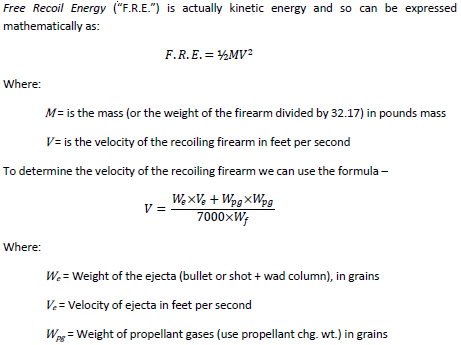
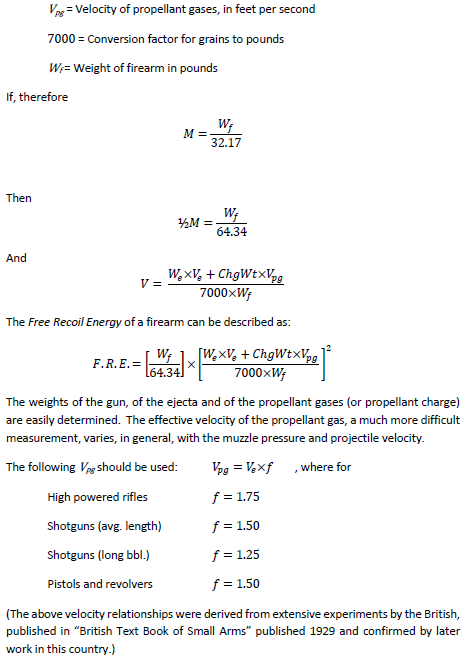
NOTE: Firearm weight must be in pounds, ejecta and propellant charge in grains, and velocity in feet per second. Free Recoil Energy will then be expressed in foot-pounds.
EXAMPLE: How much Free Recoil Energy would be developed by an average length shotgun weighing 7 pounds firing a 12 ga 2¾” load of 1¼ ounces of #4 shot at 1,275 fps with wads weighing 43 grains and loaded with 33.4 grains of propellant?
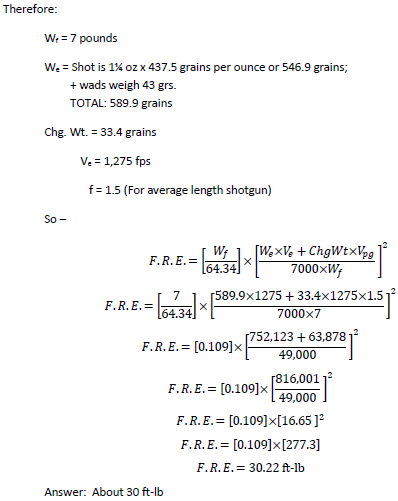
The exact F.R.E. for a given shot would depend upon the exact weight of the shot charge and exact velocity of that shot.
Calculations may be made in the metric system if firearm mass is given in kilograms; ejecta and powder charge mass in grams and the velocity in meters per second. The equation would then take the form:
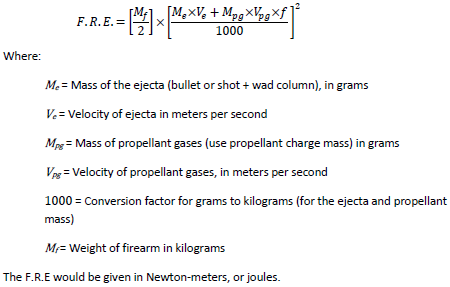
The “yard stick” of terminal energy on a physical basis is the expenditure of energy into the target media. The energy we speak of in ballistics is called kinetic energy, and is defined as the product of one-half the mass of a body and the square of its velocity (½ m v2).
Wound formation is a direct function of the kinetic energy that is transferred into the target. Kinetic energy that is not transferred into the target is wasted energy.
While kinetic energy is very important, there are other factors that must also be considered in the effectiveness of a bullet to ethically harvest game. Structural damage, blood loss, nervous system failure, and shock are some of the desired results of the work being done through the transfer of kinetic energy. Other contributing factors to this end are bullet design, spin, velocity to stability relationship, etc.
Test data currently available indicates that, within the barrel length limits of 18½” (47.0 cm) to 28” (71.1 cm), rifle accuracy is unaffected by the length of the barrel.
For shorter barrels, like those found on handguns, shooting accurately is made more difficult due to a much shorter sight radius (the distance between the front and rear sights). As sight radius decreases, slight deviations from perfect sight alignment are magnified.
NOTE: The term ‘dram equivalent’ is obsolete and no longer used to express the velocity of shot fired from shotgun shells.
A dram was a measure formerly used for black powder and was normally used as a volume measure (although strictly speaking, it is a weight measure equivalent to 1/16 oz. or 1/256 lb.). A given dram charge of black powder imparts a certain velocity to a given weight of shot. For example, three drams of black powder with 1⅛-oz shot in 12 gauge, a 3 dram equivalent load produces a muzzle velocity of about 1,200 ft./sec. With the advent of the use of smokeless propellant in sporting ammunition, a method was needed to relate the velocity for a given shot weight of these loads to the black powder loads used previously. The “dram equivalent” system was developed for this purpose, but modern loadings depart from the system in a number instances as explained later.
Some shooters mistakenly believe a low dram equivalent is synonymous with low pressure. This is not so, as all modern shotshells regardless of dram equivalent marking, gauge, brand, powder or shot charge are loaded to approximately the same pressure level. Therefore, those who attach a significance to the term “dram equivalent” in respect to chamber pressure are in error.
The main problem is that people still confuse a “dram equivalent” designation with a “dram measure” of powder and this may be serious in the case of modern, fast-burning shotshell powders. Taking the density of black and smokeless powders into account, a volumetric 3-dram measure of such modern smokeless powders is approximately 40 grains (where a grain equals 1/7000 lb.) or about a double charge.
“MAX” or “MAG” DRAM EQUIVALENT LOADS
Steel shot, buckshot and slug loads as well as 410 bore loads were not equated to a dram equivalent as they were introduced using smokeless propellant. These loads were usually listed as either “MAX” or “magnum” (“MAG”) in the absence of a clear correlation to black powder load velocities.
NEVER USE A DRAM AS A WEIGHT MEASURE FOR SMOKELESS POWDERS!
NOTE: There are four distinct and separate sciences under the generic heading of “ballistics”.
- Internal or interior ballistics is concerned with what occurs inside a firearm in the time between primer ignition and the projectile’s exit from the muzzle.
- External or exterior ballistics is focused on the flight of the projectile after muzzle exit and prior to impact.
- Terminal ballistics is the study of impact events.
- Forensic ballistics that examines the projectile fragments and other evidence in order to establish a relationship between the projectile and a firearm.
There are few schools in the world that specialize in the teaching of the subjects of interior, exterior and terminal ballistics. For information on forensic ballistics, one should visit the websites for the NIJ (www.nij.gov) and/or BATFE (www.atf.gov).
The requirements for ballistics research or ballistics engineering are essentially no different from those for any modern field of physical research. For advanced research in ballistics, it is almost essential that the individual have the equivalent of a Ph.D. in physics. The problems involved require a very thorough knowledge of advanced dynamics, acoustics, optics and thermodynamics, along with advanced mathematics, electronics and statistics. The engineering phases of ballistics research are probably best prepared for by a good course in electrical or mechanical engineering. A great deal of modern ballistics work requires training in electronics for which an undergraduate degree in electrical engineering plus at least the equivalent of a master’s degree in electronics is required.
It may be seen from the above that the requirements are essentially no different from those which an individual would be expected to have for any scientific research job.
It should be pointed out that the field of ballistics is a very limited one insofar as possible openings are concerned. The only ballistics research laboratories in the United States focused on sporting ammunition are those maintained by the very few large ammunition and propellant companies. There is at least one Government ballistics research facility – the Ballistics Research Laboratory in Aberdeen, Maryland.
SAAMI makes available several educational and informational pamphlets and videos. Visit the SAAMI website at www.SAAMI.org.
The National Shooting Sports Foundation (NSSF) also has numerous firearm safety resources, shooting safety, hunting and conservation. Visit the NSSF website at www.nssf.org.
NO!
It is dangerous to fire a gun having Damascus or twist steel barrels with any load, either black or smokeless powder.
This conclusion has been reached after careful consideration of accidents in which Damascus barrels were found to have failed. The failure is due specifically to corrosion between the laminates which has occurred simply as a consequence of the passage of time. This corrosion, usually at the weld joints, is often times invisible on the surface and the bright and smooth appearance of a Damascus barrel surface gives no assurance that dangerous weakening of the interior of the barrel wall has not occurred.
The following literature references dealing with this subject are offered for the benefit of those who wish to study them:
“Gun Safety: Damascus-Barreled Shotguns”, NRA Website, 11/14/2016
https://www.nrafamily.org/articles/2016/11/14/gun-safety-damascus-barreled-shotguns/
“The Construction and Structure of Damascus Barrels”, The Technical Section of Game and Gun, January, 1937, pp. 56-59.
A History of Firearms, Major H. B. C Pollard, Houghton Mifflin Company, 1926, pp. 224-225.
The Gun and Its Development, 9th Edition, W. W. Greener, Cassell and Co., Ltd, 1910, pp 229-242, U.S. publishers; Bonanza Books, New York, 1967.
The Modern Shotgun, Vol. 1, Major Gerald Burrard, Herbert Jenkins Ltd., 1931-1932, Vol. I, p. 24; Vol. III, p. 344.
“Gun Bursts and How to Avoid them”, Bob Nichols, Field and Stream, May, 1938, p. 98.
“Dangerous Damascus”, Warren Page, Field and Stream, February, 1948.
Gough Thomas’s Gun Book, G. T. Garwood, Am. Ed. Winchester Press, N.Y. 1970, pp. 58, 60, 96 et. seq.
“Damascus Safety”, The American Rifleman, National Rifle Assoc.,
Washington, D.C. August 1965, p. 85.
“Damascus Barrels – Beautify but Deadly”, Lee Kennett, Gun Digest 26th Edition, 1972, Follett Publishing Co., Chicago, pp. 184-188.
“There’s Danger in Damascus”, J. W. Houlden, Gun Digest 14th Edition, 1960 reprinted from C.I.L. Oval, June 1950 (Canadian Industries, Ltd.).
The Shotgun Book, Jack O’Conner, Alfred A. Knopf Co., New York, 5th printing 1973. References throughout.
“Damascus Barrels: Too Risky?”, The American Rifleman, National Rifle Association, Washington, D.C., April 1976, p. 24.
“Making Damascus Barrels”, Part I, The American Rifleman, National Rifle Association, Washington, D.C., April 1976 (et. seq.) p. 25.
NOTE: “Re-chambering” in this context, means the cutting of a new chamber in a previously-chambered barrel to accommodate a different cartridge of the same bore diameter. This is different from “rebarreling” which entails replacing the barrel of a firearm with one of a different chamber.
SAAMI has not published voluntary recommended practices or procedures for re-chambering of firearms. It is possible the re-chambering of a firearm may not have been done properly or may not have been properly marked on the firearm. If the caliber or gauge/length marking is missing or altered in any way, you should not use the firearm. You should instead have the firearm examined by a qualified person to determine what caliber or gauge ammunition can safely be used in that firearm.
WARNING! Failure to precisely follow the reloading recommendations and use exactly the same materials specified by recognized authorities who have access to ammunition pressure measuring equipment can result in property damage, personal injury and death. Do not make any substitutions of powders, “fillers”, or components.
Components are available in the marketplace today, suitable for reloading shotgun shells containing non-lead shot. As with all reloading activities, SAAMI recommends using high-quality components and that you carefully and strictly following the handloading instructions of the component manufacturers. The reasons are as follows:
- Slight variations in components using the same powder charge weight may result in sharp changes in pressure that, in turn, can create hazardous conditions.
- Changes in loading techniques which occur from one individual reloader to another may result in significant variations in pressure and performance.
The following list of specifics of handloading non-lead-shot shotshells is based on some of the characteristics of non-lead shot that have so far been identified.
Members of the shooting public, particularly handloaders, should be aware of the fundamental cautions applicable to non-lead shot shotshells.
SPECIFICS
- Non-lead shot should never be substituted for lead shot in factory-loaded shells of any gauge.
- Steel shot for shotshells is a specially-manufactured product considerably softer than air rifle shot, peening shot, ball bearings and other commonly available steel ball products. No attempt should be made to use other types of steel pellets (such as air rifle shot, peening shot, ball bearing, etc.).
- Components designed for loading in non-lead shot shotshells should not be used in lead-shot loads unless specifically recommended for such dual use by the manufacturer.
- No components (shells, powders, primers, wads, pouches, etc.) other than those specifically recommended by the manufacturer as suitable for non-lead shot shotshells should be used in handloading such shells.
- Special shot pouches, collars, or other protective means of insulating non-lead shot from the barrel wall during firing are essential to prevent possible barrel damage. Conventional pouches as recommended for use in lead shot shotshells are not adequate in non-lead shot loads.
- Handloading recommendations for lead shot shotshells must not be used for non-lead shot loads and vice versa.
- Steel plates or other hard surfaces should not be used for patterning non-lead shot shotshells because of the possible hazard of pellet bounce or ricochet.
- Dental damage may result from biting on any type of shot pellet. The same caution exercised when eating game bagged with lead shot should be observed when non-lead shot is involved.
NO! Never add filler or buffer material unless the specific reloading formula from a recognized authority calls for filler or buffer material.
WARNING! Failure to precisely follow the reloading recommendations and use exactly the same materials specified only by recognized authorities who have access to ammunition pressure measuring equipment can cause property damage, personal injury or death. Do not make any substitutions of powders, “fillers” or components.
EYE PROTECTION
SAAMI strongly recommends that eye protection be worn while assembling, disassembling or cleaning firearms, handloading ammunition, shooting, hunting or closely observing shooters.
The use of safety glasses intended for use while shooting and compliant with the requirements of ANSI Z87.1 is recommended.
HEARING PROTECTION
Repeated exposure to the high sound levels of discharging firearms can cause permanent hearing damage which may not be discovered until it is an irreversible fact. Due to this hazard, shooters and observers of those engaged in shooting sports activities should wear hearing protection.
SAAMI strongly recommends that quality hearing protection, appropriate for the conditions, be worn while shooting or during the close observation of shooters. In general, the highest possible Noise Reduction Rating (“NRR”) available is preferred, up to and including the potential for using double hearing protection (earplugs and earmuffs). Hearing protection manufacturers may be able to provide a recommendation on the minimum NRR appropriate for specific shooting situations.
No firearm repairs should be attempted by unqualified personnel. Incorrectly performed repairs on firearms can create an unsafe firearm that can cause property damage, personal injury or death. It may also void the manufacturer’s warranty.
Information on authorized repair facilities should be obtained from the firearm’s manufacturer. If the manufacturer of the firearm is no longer in existence, consult a qualified gunsmith with credentials from an accredited gunsmith program for advice or repairs.
In the event of a failure to fire (misfire), the following procedure should be followed:
- Keep muzzle pointed in a safe direction.
- Wait several seconds.
- With muzzle still pointed in a safe direction, if possible, place safety in “ON” or “Safe” position.
- With muzzle pointed in a safe direction and while protecting yourself and others from exposure to the breech area of the firearm, remove the magazine (if applicable), open action quickly and remove the misfired round from chamber.
- Remove all ammunition from the firearm and check to be sure bore is clear and unobstructed.
- If you experience repeated failures to fire, consult the manufacturer, the manufacturer’s authorized repair center, or a qualified gunsmith to determine the cause of misfires. Do not use the firearm until it is repaired.
WARNING: It is extremely hazardous to experiment with, manufacture, or attempt formulation of priming or propellant explosive compounds or mixtures because it could result in property damage, serious personal injury or death In addition, there is a high likelihood that such activity would be in violation of Federal, State and/or local laws.
For reasons of your own safety and health and of those around you, it is our policy to urge everyone to NOT experiment with, or attempt manufacture of, priming and/or propellant ingredients or compositions.
SAAMI is an American National Standards Institute (ANSI) accredited standard developer(ASD). SAAMI and ANSI make available to the public ANSI/SAAMI Voluntary Industry Performance Standards developed under procedures affirmed by ANSI entitled Voluntary Industry Performance Standards for Pressures and Velocities of Sporting Ammunition, and certain dimensional characteristics, of four types of sporting ammunition. They were subject to the concurrent review and canvass procedures of ANSI before recognition by the ANSI Board of Standards Review and publication by SAAMI.
THESE STANDARDS SHOULD NOT BE CONFUSED WITH MANUFACTURING SPECIFICATIONS WHICH ARE WITHIN THE SOLE PURVIEW OF INDIVIDUAL COMMERCIAL PRODUCERS.
Electronic copies of the ANSI/SAAMI Voluntary Performance Standards are available for download at www.saami.org.
In order to enable consumers to clearly identify ammunition and the firearms for which it is intended, SAAMI maintains a list of accepted names and abbreviated names for each cartridge standardized within SAAMI. Those lists are published in the ANSI/SAAMI Z299.1, .2, .3, and .4 standards and are available via the SAAMI website at www.saami.org.
The SAAMI Technical Office should be contacted for cartridge names and abbreviations not listed in those documents. This includes newly-introduced and inactive cartridges.
Due to the numerous different types of cartridge loads currently offered in the commercial market, it is advised for individuals with questions related to the exterior ballistics of a specific load to research the ammunition manufacturer’s website or contact the manufacturer’s customer service department.
A list of SAAMI member companies with links to their websites can be found here.
Due to the numerous different types of cartridge loads currently offered in the commercial market, individuals with questions related to the exterior ballistics of a specific load are advised to contact the ammunition manufacturer’s customer service department.
SAAMI provides information on ammunition and component storage in its informational publication Recommendations for Safe Ammunition Storage and Handling.
The manufacturer’s documented practices described in the firearm’s owner’s manual should be consulted for specific instructions on the proper care and maintenance of your firearm. Further, the SAAMI pamphlet Recommendations for Ammunition Safe Storage and Handling provides additional important information on the practices to maintain the quality and performance of ammunition that supplements information provided by the manufacturer.
- Definition
An interior constriction at or near the muzzle end of a shotgun barrel bore for the purpose of controlling shot dispersion. - Common Choke Nomenclature
- Full Choke: Greatest constriction (tightest patterns)
- Improved Modified: Constriction between Full and Modified
- Modified: Moderate constriction
- Improved Cylinder: Slight constriction
- Skeet: Slight constriction intended to produce even patterns at shorter ranges.
- Cylinder Bore: No constriction (largest spread/open pattern)
Note that other names are used for constrictions not included in this listing and are generally intended for special purposes such as turkey hunting.
- Characteristics
Shotgun chokes have been historically named as they relate to pattern density. There are no standards for choke dimensions and each manufacturer will vary the configuration to meet their patterning requirements. - Interchangeability
SAAMI has no standard related to the thread patterns/location of interchangeable choke tubes. Users should consult the manufacturer of their shotgun for information on availability of choke tubes for use with their specific shotgun. - Rifled Choke Tubes
Rifled choke tubes for use specifically with slugs are also available. SAAMI has no standard related to these products and recommends the consumer contact the slug load or choke manufacturer for specific recommendations on the use of these chokes with the slug load intended to be used.
Evidence presently available indicates that patterns are unaffected by changes in barrel length within the limits of 20” (51 cm) to 36” (91 cm).
Remembering that production tolerances in diameter and variation in alloy composition will cause differences in actual pellet counts, the nominal pellet counts per ounce by shot size and material are provided in the SAAMI Z299.2 Standard available on this website.

